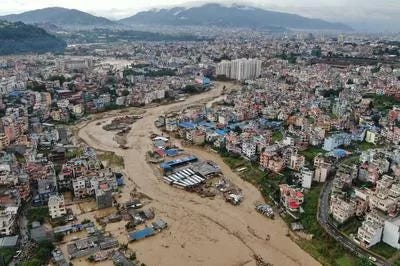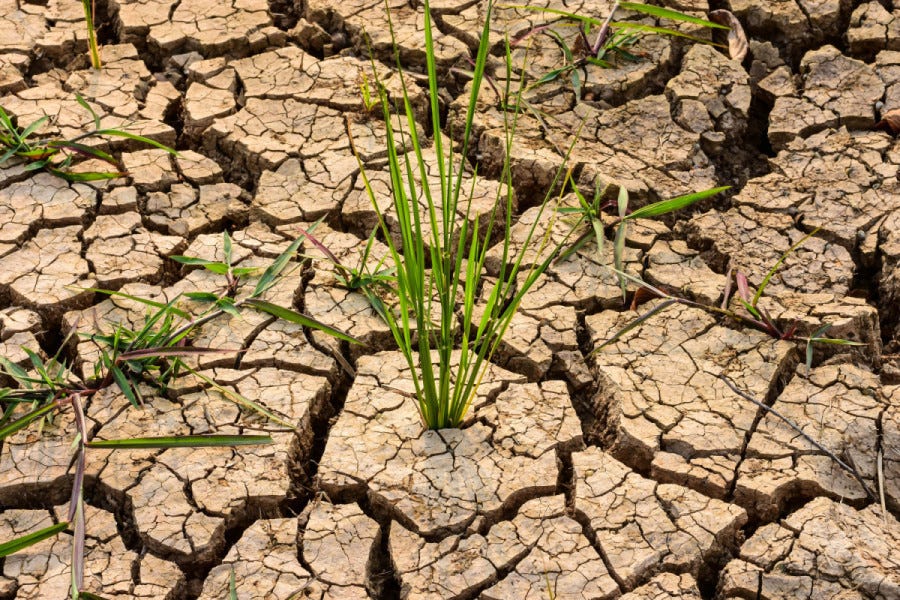Climate crisis in Nepal: Farmers as the First Refugees
Migration is a longstanding phenomenon in Nepal, with rural residents yearly moving to cities in search of better facilities. The well-developed infrastructure, quality education, healthcare, and various convenient facilities draw people from villages to urban areas. Similarly, people from urban areas too relocate in pursuit of improved livelihoods. However, there is a growing trend of individuals departing from their villages, not merely in search of better opportunities, but because they are compelled due increasingly challenging circumstances. In recent years, many people have been displaced from their homes due to natural disasters, with the frequent occurrence of floods being one of the primary causes.
Currently, approximately 60% of Nepal's population is engaged in agriculture, with many farmers are still below the poverty line. Due to their insufficient income, these farmers often struggle to maintain a decent standard of living, as their earnings are inadequate to meet their basic needs. Even minor changes in their circumstances can lead to significant disruptions in their lives. In Nepal, farming is often carried out under challenging weather conditions. Favorable weather can boost production, while unfavorable conditions can lead to reduced yields. This year, the onset of the monsoon season generated excitement for timely paddy planting, and the sowing was completed as scheduled. However, not every year the weather conditions will be unfavorable. While the monsoon arrived on time this year, it did not do so in the previous year, leaving uncertainty about what to expect next year. Although Nepal ranks 128th among the world's carbon-emitting countries, it is significantly impacted by climate change, ranking fourth in terms of its vulnerability to its effects. As a large part of the population depends on agriculture, climate change has caused a lot of harm in Nepal and continues to create serious problems. As a result, farmers will be the most affected, putting their future at risk.
Yearly all over Nepal, flood and landslides cause huge loss in agricultural land, harvested products and even agricultural markets. The recent floods in October, 2024 have caused devastating losses to the Nepalese economy. The rainfall pattern in recent year has been unpredictable. Rains have become intense during the end of monsoon. Nepal got more rainfall in two days than the entire year. This resulted in heavy flood in all over Nepal. Along with flood, landslide also made huge impact too. The flood caused more than 6 Arab of loss in agricultural commodities only. The standing paddy field was flooded all over Nepal making significant damage to paddy production. In addition to paddy fields, agricultural commodities transported from all over Nepal were stuck in areas lacking proper road access. This cause the perishable agricultural goods got rotted on the way. The damage caused by the floods and landslides was so severe that it remains uncertain whether farmers will be able to cultivate and grow crops in the affected fields in coming years.
Similar case was occurred in August 2024, a flash flood triggered by the breaking of the Chomuche glacier nearly displaced the entire village of Thame in Solukhumbu district. The flood affected all 55 homes of the village, leaving none unaffected. Beyond the physical destruction, the flood swept away livestock and agricultural land as well. The settlement needed relocation to different area. Not only Chomuche, there are 21 'potentially dangerous' glaciers in Nepal that can erupt at any time. The burst of any of these vulnerable glaciers would pose a severe threat, with particularly high damage likely in hilly regions. The glacial outburst can cause floods and landslides, which damage standing crops and pose a severe threat to food security. In the initial stages, the water table may rise, but this often leads to prolonged drought during dry seasons. This causes difficulties in irrigation and can lead to complete crop failure. Not only is irrigation affected, but the top nutrient-rich soil is also washed away as glaciers melt. The topmost nutrient-rich soil is the backbone of agriculture, and without it, farmers struggle to produce healthy crops and sustain their livelihoods. As a result, farmers may be forced to leave their profession and residential areas in search of better livelihood options.
Terai region of Nepal is known as basket of agriculture. The fertile land of terai supports more than one third of Nepalese food system. But in recent years, this basket is shrinking. The evidence of climate change has caused this fertile land to decrease productivity of cereals and other agricultural commodities. More than 80% of rainfall in this region occurs during monsoon. This situation has been changing in recent years. Monsoon rain becoming more intensive and prolonged drought conditions during winter is noticed. According to Global Scientific Journal, 2019 the winter rainfall in terai region specially, in chitwan, rautahat and kailali has decreased by 51 %. This forced community to search for deeper water sources ultimately leading to more disruption in water table. Prolonged drought in terai region has intensified social conflicts and disputes over natural resources, as per Overseas Development Institute (2017).
The report published by Global Report on Internal Displacement, 2021, in single year of 2020 the number of people displace within country in Nepal was about 48,000 in between June and September. Same report published in 2024 showed that internal displacements during 2023 have increased to 110,000. The number has increased sharply within 3 years. The report indicates that the majority of displaced individuals are farmers and daily wage laborers. In Nepal, where a large portion of the population relies on agriculture, farmers are among the most vulnerable to climate-related disasters. When calamities occur, farmers are often disproportionately affected and face a higher risk of displacement, sometimes leaving them in refugee-like situations. Unlike other professions, farming is deeply sensitive to environmental shifts, and climate change has taken a severe toll on their livelihoods. This impact is further compounded by their generally weaker economic situation, making it harder for them to recover and adapt. As a result, farmers face significant challenges in rehabilitation, leading to uncertainties about the viability of continuing their farming practices even after recovery efforts.
Not only in Nepal, but since 2010, climate change-related disasters have displaced approximately 21.5 million people, according to data released by the United Nations High Commissioner for Refugees (UNHCR) in April, 2021. The point’s climate crisis also contributes to complex challenges like food and water shortages and restricted access to natural resources. In 2022, climate-related natural disasters led to the displacement of 36.2 million people. While many sought safety within their home countries, others were compelled to cross borders. According to the International Federation of Red Cross and Red Crescent Societies (IFRC), the number of people affected could double by 2050.
The devastating case of Syria may be one of the greatest lessons to world. Syria, once a fertile region; the birthplace of agriculture, is now facing severe situation caused by climate-related issues. Farmers are facing severe drought causing them to dig more than 700m to find water. Before drought farmers could find water in just 60 to 70 m. As a result, drought has destroyed crops, and killed livestock. More than 2 million farmers were displaced by 2013. In 2023, the internal displacements during disaster were 702,000. The remaining farmers had to face the civil war because of lack of job and social security. Despite the ongoing war, Syria’s environmental issues persist. These problems make refugees reluctant to return home. Even if the conflict ends, they may still hesitate due to these challenges.
In case of Nepal also, the water resources are drying up at alarming rate. The studied conducted by RWSSP-WN on Tanahun district from 2004 to 2014 found that the point source water has dried up to 50%. In another case study of Melamchi, by 2017, water volume in local springs has declined by 30% over the past decade. This situation can be seen all over Nepal. By this rate people will not enough water to drink and there will be nearly impossible to allocate enough water for irrigation. In 2024, people from Sarlahi district came to protest in Kathmandu by walking for about 23 days just to make parliament aware about the water crisis facing by them. And believe me, it’s just a beginning.
Climate change is expected to cause more severe damage in Nepal in the coming years, with farmers facing the greatest impact. Not only flood, landslide and drought, but also the outbreak of unexpected pest and diseases will cause farmer to face difficulty for growing crops. The global temperature rise changes the growing degree day, resulting in complete failure of crops, where once was abundant. The social and economic conditions of Nepalese farmers are currently too weak to cope with the challenges that climate change will create. Consequently, many farmers may have no choice but to leave their homes in pursuit of better opportunities in other areas, requiring them to take up different jobs to sustain themselves and their families.






